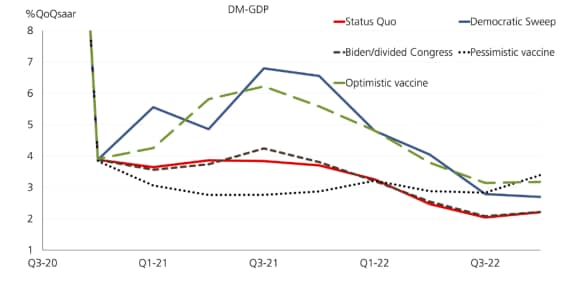Economics Global Economics & Strategy - How Will US Election & Vaccine Trajectories Shape Markets?
Two events in the next few months will significantly shape markets for the next two years, namely vaccine(s) and the US election. UBS Research take a detailed look.
Two keys to the outlook: Vaccine(s) and US Election
Two keys to the outlook: Vaccine(s) and US Election
Two events in the next two months will significantly shape markets the next two years: (i) the potential availability of a vaccine will determine how quickly consumption can ramp back up to aid the recovery (in Europe and the US, 23½mn previously employed people are still 'inactive' or unemployed); and (ii) the US election will determine how much fiscal stimulus is possible, and potentially also whether there will be a new trade war with China. We construct updated scenarios for the three main election outcomes, as well as optimistic and pessimistic trajectories for vaccine approval and rollout.
Globally, a Democratic sweep is roughly equivalent to a rapid vaccine rollout
Globally, a Democratic sweep is roughly equivalent to a rapid vaccine rollout
This is partly as we now assume a $1½ trillion stimulus package under a Dem sweep scenario, with tax increases delayed until 2022. That lifts US growth nearly 300bp above scenarios where Congress is split, generating a 'beta' effect (6.2% global growth) that is roughly equal to the demand acceleration that would take place if the virus count fell rapidly. "Trump/status quo" and "Biden/divided Congress" scenarios are remarkably similar in their outcomes (global growth 150bp lower than Dem sweep) as we assume trade escalation under Trump would be offset by somewhat more stimulus. A delayed rollout of a vaccine is, however, worse. This would leave DM with higher unemployment and several additional years of output gap closure. Monetary policy is maxed out. The policy delta is in fiscal policy and asset purchase programs.
Vaccine: What's priced and where to position for it
Vaccine: What's priced and where to position for it
Our model shows that the median contribution of vaccine hope across regions and equity factors is about 8.6%. This is also an estimate of how much downside there is to equities in the worst-case scenario where vaccines are not just delayed, but unsuccessful. While vaccine hope is nearly 80% priced in US Growth, it is only 46% priced in US Value and 48% priced in EM Value.
Equities: Dem Sweep second-best for S&P 500, but top for global stocks
Equities: Dem Sweep second-best for S&P 500, but top for global stocks
Into end-2020, S&P 500 is likely to do better under a Democratic sweep than under any other scenario. Into 2021, however, gains are likely to decelerate significantly as earnings are hit by expectations of taxes and valuation is dented by higher rates. The S&P 500 should find renewed momentum in 2022, but its cumulative two-year gains are likely to be superior under Biden with a split Congress. With high import multipliers of spending under a Dem sweep, global markets are likely to outperform the S&P 500. This outperformance is likely to be front-loaded though—S&P is unlikely to lag in 2022.
Fixed Income: High supply means US 10y heading gently higher in all scenarios
Fixed Income: High supply means US 10y heading gently higher in all scenarios
Supply only matters at extremes and we are at an extreme in the US. Over the next two years, 10y US yields could rise by over 100bp if a Dem sweep or early vaccine success crystallise. With a very different net supply position, Bund yields are likely to move with a beta of only 0.4-0.5 to US Treasuries. Liquidity will continue to explain credit spreads better than fundamentals. We see tighter credit spreads in most outcomes.
FX: The dollar is unlikely to benefit from strong US growth
FX: The dollar is unlikely to benefit from strong US growth
The low level of US real interest rates and high twin deficits make it likely that the dollar stays on the back foot, including, at least for the short term, against EM currencies. The exception is a continuation of the status quo, which would delay dollar losses against G10 to 2022, and could lead to sharp losses for EM. Biden with a split Congress should be the most positive for emerging markets fixed income


